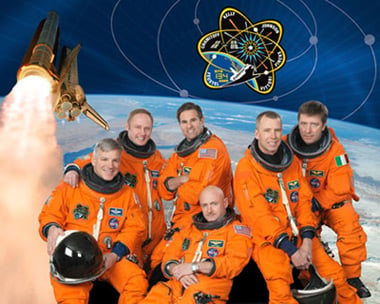This article is more than 1 year old
Endeavour 'ready to go fly'
Last launch of shuttle on 29 April
Space shuttle Endeavour is "ready to go fly" on its 25th and final mission, and will bow out with a last trip to the International Space Station.
 The veteran vehicle will blast off on at 19:47 GMT on 29 April from Kennedy Space Centre's Launch Pad 39A. On board will be commander Mark Kelly (bottom centre) and (clockwise) pilot Gregory H. Johnson, and mission specialists Michael Fincke, Greg Chamitoff, Andrew Feustel and the European Space Agency’s Roberto Vittori.
The veteran vehicle will blast off on at 19:47 GMT on 29 April from Kennedy Space Centre's Launch Pad 39A. On board will be commander Mark Kelly (bottom centre) and (clockwise) pilot Gregory H. Johnson, and mission specialists Michael Fincke, Greg Chamitoff, Andrew Feustel and the European Space Agency’s Roberto Vittori.
Following the Flight Readiness Review yesterday which cleared Endeavour for lift-off, NASA's associate administrator for Space Operations, Bill Gerstenmaier, said: "We had a very extensive and thorough review today. I think the things that impressed me the most is that the team is still continuing to really work issues and look at the vehicle performance on each and every flight just like they would during any normal mission."
Mike Leinbach, shuttle launch director, added: "The final processing flow for Endeavour is going extremely well out at the pad. I'm very proud of the team and we'll going to have a good launch and a good mission."
Endeavour first launched on 7 May 1992, on STS-49. Career highlights include first servicing mission to the Hubble Space Telescope in December 1993, and delivery of the first American component of the space station, the Unity Module, during December 1998's STS-88.
Its swansong mission is STS-134, which will deliver the "the Alpha Magnetic Spectrometer (AMS) and spare parts including two S-band communications antennas, a high-pressure gas tank, additional spare parts for Dextre and micrometeoroid debris shields".
NASA describes the AMS as "a state-of-the-art particle physics detector" which "will use the unique environment of space to advance knowledge of the universe and lead to the understanding of the universe's origin by searching for antimatter, dark matter and measuring cosmic rays".
 During its nominal three-year mission, the AMS will sniff cosmic radiation levels to provide important data on just how future astronauts can be protected on long interplanetary trips.
During its nominal three-year mission, the AMS will sniff cosmic radiation levels to provide important data on just how future astronauts can be protected on long interplanetary trips.
On a less practical level, the device will be keeping an eye out for the theoretical strangelet particle - an "extraordinary" blend of u, d and s quarks which is potentially "a totally new form of matter".
It's also tasked with hunting the "neutralino" - another theoretical particle which is among the candidates for dark matter.
All of that adds up to an awful lot of information. NASA explains the AMS will "collect data 24 hours a day, 7 days a week, and 365 days a year".
It adds: "As long as the experiment has power provided by the ISS, the detectors will be on and measuring data at a rate of 7 Gigabits per second. This is equivalent to filling a 1 Gigabyte USB memory stick every second! Using sophisticated filtration and compression techniques, the advanced 600 computer processors located on AMS are able to reduce the amount of data down by a factor of 3000. This data is sent from the ISS to the ground where researchers around the globe will compile and analyze data."
Its work done, Endeavour will be put on permanent display at the California Science Center in Los Angeles. NASA has a fact sheet on the shuttle here (pdf), and an STS-134 mission summary here (pdf). ®
